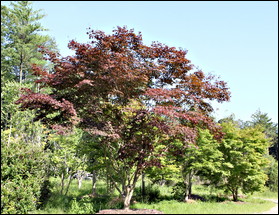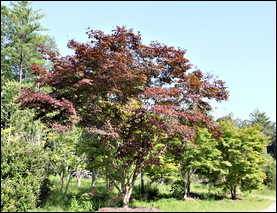 A ball and burlapped tree, ready for its new home. |
Large specimens and hard-to-move varieties are usually transplanted with a ball of soil to avoid breaking the roots and to protect them.
To prepare a proper root ball, dig a trench around the tree, leaving the soil around the trunk untouched. The soil should be moist, not too dry and not soaking. The size of the ball is determined by the diameter of the trunk:
| 2-inch trunk | 24-inch root ball | 300 pounds |
| 3-inch trunk | 32-inch root ball | 750 pounds |
| 4-inch trunk | 40-inch root ball | 2,000 pounds |
Obviously, moving large specimens is not a job for the weekend gardener. It requires a strong back and a good helper. And there’s no guarantee the trees will survive. That’s why using trees creatively where they already exist makes good sense and saves the most money. It’s much easier to design around a large tree than to move it.
If large trees must be moved, consider hiring a good landscape firm with an experienced staff, cranes, and other proper equipment. Most large trees today are dug with a tree spade, a large machine that scoops them out of the ground with pincers. Wire baskets are used to keep the root ball intact. Inside the wire frames there often is burlap, especially plastic burlap. Since the burlap can’t be removed from inside the wire frame, it must be completely slit in many places, up and down. The wires are usually left because it is not practical to remove them from a several-ton root ball. They can be clipped with heavy wire cutters, however. The tops of the wire baskets are usually bent down to be under the soil. Studies are being done to see whether, after a long time, the wire baskets cause problems, but since they are yet inconclusive, clipping the wires is good insurance.
 A ball and burlapped tree, ready for its new home. |
Commercially Grown Trees
Sometimes it’s just cheaper and easier to buy new trees than to try and move the older ones. Most commercially grown trees have good root systems, carefully developed by frequent root pruning. Many small trees that are sold as balled and burlapped, however, are actually not dug with root balls. They are dug bare rooted, covered with soil and wrapped up. They survive perfectly well but should cost less. Care has to be taken to not break the root ball when planting, although this is often unavoidable.
A properly dug specimen will have a hard, firm root ball that holds its shape when kicked or replanted, even after the burlap is removed. Proper balling and burlapping is very expensive, and few experienced laborers are left who know how to do it. So it is reserved for specimen trees and evergreens as well large flowering and shade trees.
Credit: www.mothersgarden.net




























